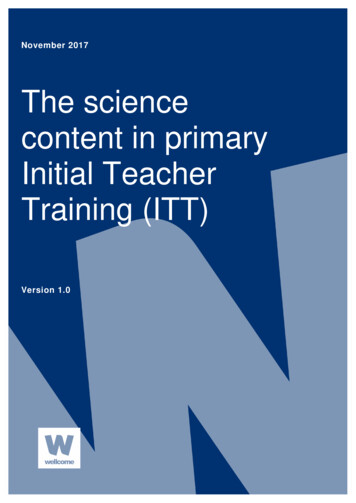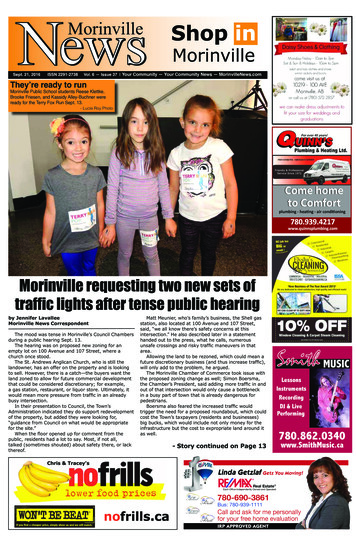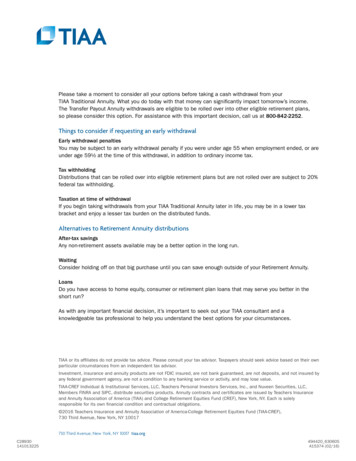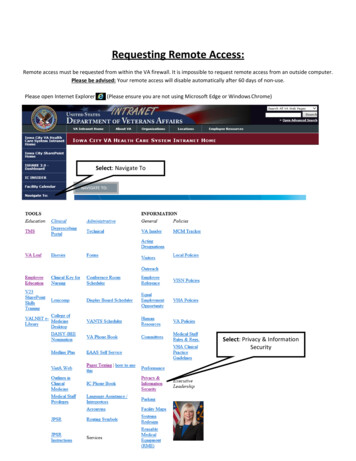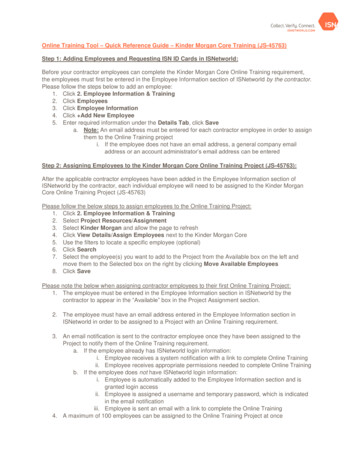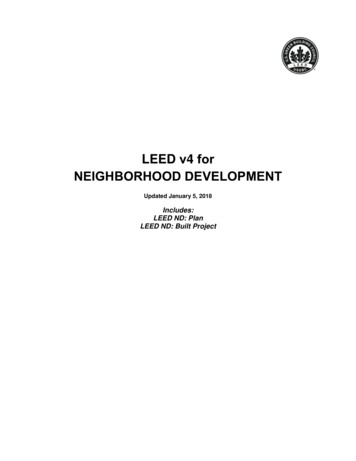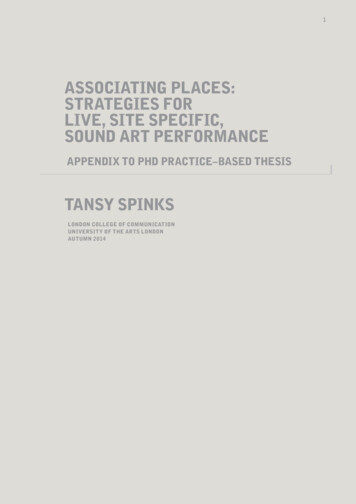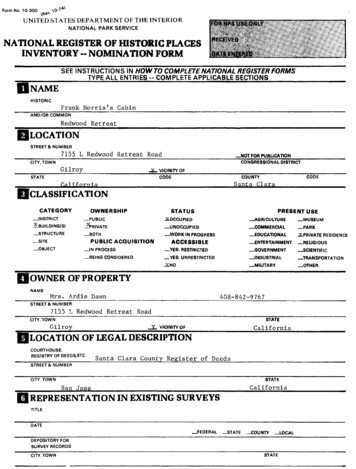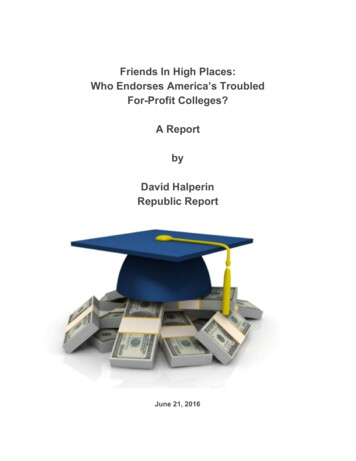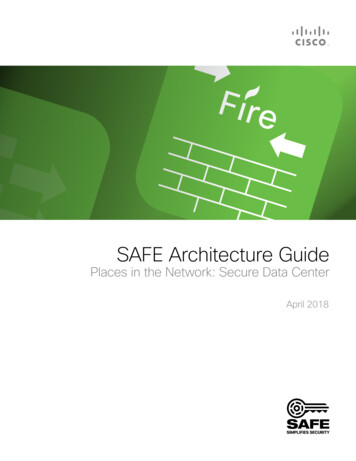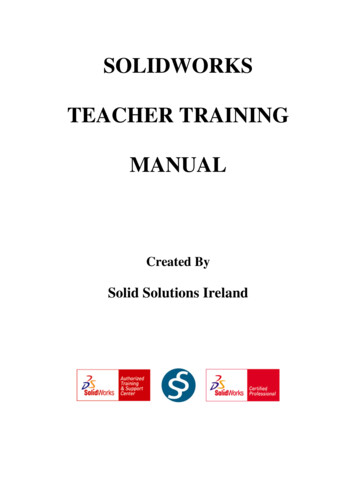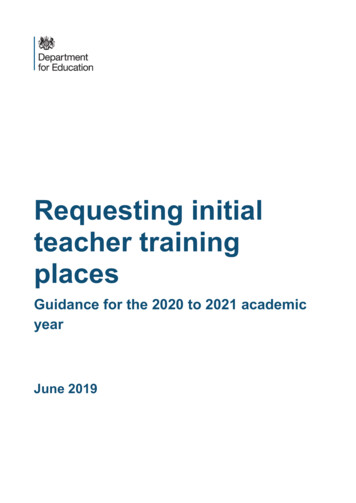
Transcription
Requesting initialteacher trainingplacesGuidance for the 2020 to 2021 academicyearJune 2019
Contents1. Introduction32. The request period6New ITT providers6New lead schools63. Permission to recruit requirementsFind postgraduate teacher training4. Process for ITT providers: requesting permission to recruit779Requesting undergraduate ITT places9Requesting Early Years places9Multiple Year Allocations5. Process for lead schools: requesting permission to recruit1011Eligibility11Lead school partnership information126. Additional information13Requesting Primary with Maths places13PE with EBacc13ITT Funding147. Next Steps15Annex A: List of designated ITT subjects16Early Years16Primary16Secondary16
1. IntroductionThis guidance sets out the process for requesting permission to recruit to initial teachertraining (ITT) courses 1 that begin in the academic year 2020 to 2021.The process applies to the 2020 to 2021 academic year only. DfE, or any successororganisation, may modify or amend the approach taken in future years.Courses leading to Qualified Teaching Status (QTS)A range of routes is available for people to train to become a teacher, all leading to QTS.These routes include (but are not limited to):Postgraduate Provider-led: where a tuition fee is payable to the accredited ITT provider to coverthe cost of training. Training places are held by the ITT provider. School Direct (fee-funded): where a school partnership works with an ITT providerto which a tuition fee is payable to cover the cost of training. Training places areheld by the lead school. School Direct (salaried): where a school partnership works with an ITT providerand the trainee is employed within the school partnership. Training places are heldby the lead school for the partnership in which the trainee is employed. Postgraduate Teaching Apprenticeship: where a school partnership works with anITT provider that is on the Register of Apprenticeship Training Providers (RoATP)and the apprentice is employed within the school partnership. Training places areheld by the lead school on behalf of the partnership in which the apprentice isemployed. This is an employment-based route where the trainee is employed forthe duration of the course (a minimum of 12 months), which includes an additionalapprenticeship end-point assessment following the award of QTS. Moreinformation on the Postgraduate Teaching Apprenticeship is available on gov.uk 2.Undergraduate Where a tuition fee is payable to the ITT provider to cover the cost of training.Training places are held by the ITT provider and training is typically deliveredalongside undergraduate study.1 The term ‘courses’ in this document refers to each subject and route combination. For example, PhysicsSchool Direct (salaried) is a different course type to Physics School Direct (fee-funded). Postgraduate andundergraduate routes in any given subject are also defined as different courses.2 apprenticeships-guidance-for-providers3
2020 to 2021 course categoriesFor 2020 to 2021 recruitment to ITT courses falls under two categories: Unlimited: recruitment to courses in this category is unrestricted. Allocated: recruitment to courses in this category is limited by the number ofplaces allocated by the Department for Education (DfE).DfE will give permission to recruit in unlimited courses and will allocate places to coursesin the allocated category. ITT providers and lead schools should note thatrecruitment to the majority of courses is unlimited for 2020 to 2021 and will also beunlimited for 2021 to 2022 3. A full list of the courses that are in the unlimited categoryfor ITT courses in 2020 to 2021 is available in Annex A.2020 to 2021 data requirementITT providers and lead schools are required to inform the DfE of all of the courses, bysubject and route, in which they plan to offer ITT for the 2020 to 2021 academic year.This includes information on the number of trainees they need for each course to remainviable, and the number they intend to recruit for the 2020 to 2021 academic year. ITTproviders will also be asked to give an indicative forecast for the next three years foreach course. This information must be submitted to allow them to list their courses asopen for recruitment on ‘Find postgraduate teacher training’ and UCAS, and to accessany DfE funding associated with training places. DfE requires this information tounderstand demand and capacity in the system nationally.Early Years courses leading to EYTS:There is a range of routes available for people to train as an Early Years teacher leadingto the award of Early Years Teacher Status (EYTS). There are two graduate fundedroutes and an undergraduate route.Early Years teachers are specialists in early childhood development, trained to work withbabies and young children from birth to five years old. EYTS is awarded to graduateswho have been judged to have met all of the ‘Teachers’ Standards (Early Years)’ inpractice from birth to the end of the Early Years Foundation Stage /teacher-recruitment-and-retention-strategy4
Early Years ITT leads to Early Years Teacher Status, awarded by DfE. DfE will onlyaward EYTS to trainees who have completed training at an ITT provider with an EarlyYears ITT allocation.5
2. The request periodITT providers have until midday Friday 12 July 2019 to submit information on the ITTcourses they plan to offer for academic year 2020 to 2021, using the 2020 to 2021request template spreadsheet. We will not use DTTP to collect requests information.Only ITT providers can submit request templates to DfE for 2020 to 2021. ITTproviders must return all requests to DfE using the request template spreadsheet. Theyshould input information on provider-led courses, as well as all courses they agree toratify on behalf of their School Direct partners (School Direct and Postgraduate TeachingApprenticeship).Partnerships can decide for themselves whether lead school request templates arecompleted by the lead school or the ITT provider, as long as they are submitted to DfE bythe ITT provider. By submitting these requests, they also ratify them. ITT providers willnot need to ratify requests on the DTTP separately.ITT providers should agree requests being made on behalf of lead schools and ensurethey submit all requests before midday Friday 12 July 2019. ITT providers should e-mailtheir completed template(s) to ITT.allocations@education.gov.uk.New ITT providersDfE will communicate directly with all new ITT providers that are accredited after therequest window closes at midday 12 July 2019 with further information on course deliveryfor the 2020 to 2021 academic year.New lead schoolsNew lead schools must register as a lead school using the ‘Lead school registrationtemplate’. It is advised that schools wishing to become a lead school first consider joiningan existing partnership in their area.Only schools judged by Ofsted as ‘good’ or ‘outstanding’ are able to register as a leadschool. The minimum partnership size is five partner schools (or three for specialschools). This also applies to lead schools planning to offer the Postgraduate TeachingApprenticeship route.Schools may request a lead school registration template by e-mailingitt.allocations@education.gov.uk.6
3. Permission to recruit requirementsITT providers and lead schools should specify their minimum viability and forecast cohortsizes for their training programmes for each ITT course their partnership will offer for the2020 to 2021 academic year.ITT Providers and lead schools should note that the ‘forecast’ figure replaces the‘maximum’ figure required in previous years. The ‘forecast’ figure should reflect thenumber of trainees the partnership expects to realistically recruit to that course and notmaximum capacity.For their forecast cohort sizes, they should consider their most recent cohort sizes,recent recruitment patterns, recent trends in applicant route preferences and a realisticassessment of employment need in their area(s) of operation. The forecast shouldequally take account of partnership capacity for training and their ability to attract andrecruit candidates who will make excellent teachers. This information will help DfE to gaina more accurate understanding of capacity in the ITT market. There will be no penaltiesfor recruiting under or over this figure for unlimited courses. DfE may use thisinformation to inform future policy development.A separate 3 year indicative forecast should reflect the partnership’s plans over a longerperiod. ITT providers should indicate whether they expect their cohort for each subject toincrease, decrease or stay roughly the same. If there are no plans to specificallyincrease or decrease the cohort size, it should be logged as ‘maintain a similarsize cohort’.ITT providers and lead schools have a responsibility to ensure that DfE funding, data andreporting requirements are met, and therefore are responsible for submitting accurateinformation on minimum viability, forecast cohort sizes and future forecasts for theirtraining programmes. For ITT providers, accurate data returns relating to both providerled and School Direct courses are an important aspect of ITT provider compliance (seeITT criteria for more detail). Requests to amend or correct data beyond the deadline willonly be considered in exceptional circumstances.An automatic response will be sent by the itt.allocations@education.gov.uk mailbox whenan e-mail request has been safely received.Find postgraduate teacher training‘Find postgraduate teacher training’ is DfE’s new search tool for postgraduate ITTprogrammes in England. ITT providers and lead schools must provide accurateinformation during the request window to ensure that courses are listed correctly online.UCAS will continue to provide the central undergraduate admissions service and willwork with DfE to ensure all UCAS customers are kept fully informed through regular7
bulletins. Further action will be required for ITT providers and lead schools to ensure thattheir course listings are active for the 2020 to 2021 recruitment cycle.For further details, please contact becomingateacher@digital.education.gov.uk.8
4. Process for ITT providers: requesting permission torecruitProvider-led training places are held by ITT providers (SCITTs and HEIs). School Directand Postgraduate Teaching Apprenticeship places are held by lead schools, but requestsmust be submitted by the ITT provider. ITT providers should agree requests being madeon behalf of lead schools and ensure they submit all requests before the end of therequest period. Partnerships can decide for themselves whether lead school requesttemplates are completed by the lead school or the ITT provider, as long as they aresubmitted to DfE by the ITT provider.ITT providers are required to: Submit their request template and any additional request templates completed bytheir lead schools specifying the courses they plan to offer in 2020 to 2021 beforethe deadline (midday 12 July 2019) to itt.allocations@education.gov.uk. Thesemust include:o Provider-led requestso School Direct and Postgraduate Teaching Apprenticeship requests onbehalf of partner lead schools Enter specific information on the number of trainees by:o Routeo Subject (see Annex A);o Lead school (if applicable)o Course type (postgraduate, undergraduate or Early Years ITT).Requesting undergraduate ITT placesITT providers are required to inform the DfE of all of the undergraduate subjects theyplan to offer in 2020 to 2021. ITT providers should follow the above guidance torequest undergraduate places.Requesting Early Years placesThere are two graduate funded routes and an undergraduate route. ITT providers arerequired to inform the DfE of all of the Early Years ITT places they plan to offer in 2020 to2021. ITT providers should follow the above guidance to request Early Yearsplaces.9
Multiple Year AllocationsITT providers that have been awarded Multiple Year Allocations (MYA), including thoseawarded as part of the Innovation Pilot, must still inform DfE of the courses which theyplan to offer ITT for academic year 2020 to 2021 as outlined in the section above.10
5. Process for lead schools: requesting permission torecruitSchool Direct and Postgraduate Teaching Apprenticeship training places are held by leadschools. Lead schools must agree requests with their ITT provider, who will ratifyrequests by submitting the template to DfE. Lead schools must not submit requestsdirectly to DfE for 2020 to 2021, as they will not be considered.Lead schools are required to: Notify their ITT provider of the courses they plan to offer for the 2020 to 2021academic year using the template provided; Specify the details of the courses they wish to offer, by:o Subject (see Annex A);o Route - School Direct (fee funded), or School Direct (salaried) orPostgraduate Teaching Apprenticeship;o Minimum viable cohort sizeo Forecast cohort size for 2020 to 2021o 3 year indicative forecast Ensure that their partner ITT provider ratifies their requested places by submittingthem to DfE before the deadline (midday 12 July 2019).For the Postgraduate Teaching Apprenticeship, lead schools must partner with an ITTprovider that is on the Register of Apprenticeship Training Providers (RoATP).EligibilityLead schools must be one of the following: maintained school; academy; academy trust, or academy chain head office; sixth-form college; pupil referral unit (PRU); or free school.An independent school cannot act as a lead school unless it is also a designatedTeaching School. In this instance, trainees should benefit a wider partnership of schoolsthat includes state-funded schools. Schools can request a lead school registrationtemplate by e-mailing itt.allocations@education.gov.uk.11
Lead school partnership informationAll lead schools must list the schools in their partnership on the registration templatewhen they register for ITT for 2020 to 2021 to help DfE understand the reach of ITTprovision. For data accuracy, lead schools should confirm their URN to their ITT providerand partner schools should be listed by URN.12
6. Additional informationRequesting Primary with Maths placesPrimary with Maths courses provide additional training in maths while preparing traineesto teach the full primary curriculum.All ITT Providers and lead schools are able to request permission to recruit to Primarywith Maths courses. These trainees must demonstrate the Teacher’s Standards forPrimary only, but receive additional maths training. Trainees filling these places musthave achieved a minimum of the standard equivalent to a grade B at A level inmaths to be eligible for an ITT bursary or for their employing school to receive a SchoolDirect (salaried) grant.Trainees who have not achieved a minimum of the standard equivalent to a grade B at Alevel in maths may still join a Primary with Maths course, but will not be eligible forfunding. ITT providers and lead schools may wish to put in place extra support to ensurethat any such trainee is able to meet the specific conditions of the course.PE with EBaccITT providers and lead schools are able to request additional PE places on top of theirPE allocations. Trainees filling these places are required to train in an additional EBaccsubject alongside their main specialism of PE so that they are capable of teaching this inschool. For recruitment purposes, these are ‘PE with’ courses, which require trainees todemonstrate the Teachers’ Standards in PE only, whilst receiving additional training in anEBacc subject. Therefore, there is no separate allocation category for these PE withEBacc courses.ITT providers and lead schools cannot request PE with EBacc places during the2020 to 2021 request window. These additional places can only be requested duringthe recruitment cycle on an ad-hoc basis, as eligibility is dependent on the applicant. Thepurpose of these additional places is to increase employability of newly qualified teachersto take up teaching roles in EBacc subjects.ITT providers and School Direct lead schools are responsible for the content and amountof additional training provided in the EBacc subject. ITT providers and lead schoolsshould make details of the course clear to applicants in the course description.13
ITT FundingDfE is responsible for managing bursary and grant funding for postgraduate andundergraduate ITT courses. It also monitors the public cost of student loans accessed bytrainees on these courses. Information on ITT funding for the 2020 to 2021 academicyear, including bursaries, scholarships and grants for salaried courses, will be publishedin early autumn 2019.14
7. Next StepsThe 2020 to 2021 request period will operate for lead school registration and for ITTproviders to submit their information by midday 12 July 2019.DfE will confirm recruitment permissions and allocations for courses in the allocatedcategory with ITT providers and lead schools in September 2019.15
Annex A: List of designated ITT subjectsRecruitment to all subjects listed below is unlimited for postgraduate ITT for the 2019 to2020 academic year, with the exception of those marked with an asterisk.Early Years Early years graduate entry route* Early years graduate employment-based route* Early years undergraduate entry route*Primary PrimaryPrimary with MathsSecondary Art & DesignBiologyBusiness esign & TechnologyDramaEconomicsEnglishFoodGeographyHealth & Social CareHistoryLeisure & TourismMathematicsMedia StudiesModern LanguagesMusicPhysical Education*PhysicsPhysics with MathematicsPsychologyReligious EducationSocial Studies* Recruitment to PE (fee-funded routes) will be allocated for the 2020 to 2021 academic year. DfE will alsoconfirm the position on Early Years ITT in due course.16
Crown copyright 2019This publication (not including logos) is licensed under the terms of the OpenGovernment Licence v3.0 except where otherwise stated. Where we have identified anythird party copyright information you will need to obtain permission from the copyrightholders concerned.To view this ves.gsi.gov.ukwrite toInformation Policy Team, The National Archives, Kew, London, TW9 4DUAbout this publication:enquiries www.education.gov.uk/contactusdownload 131-2019Follow us on Twitter:@educationgovukLike us on Facebook:facebook.com/educationgovuk
for ITT courses in 2020 to 2021 is available in Annex A. 2020 to 2021 data requirement . ITT providers and lead schools are required to inform the DfE of all of the courses, by subject and route, in which they plan to offer
